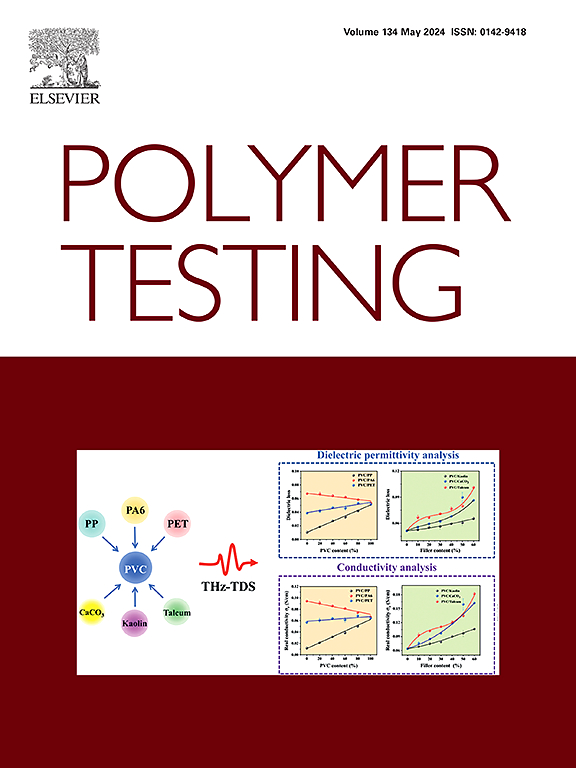从棉花糖根粘液和聚乙烯醇中提取的环保静电纺丝纤维:增强可持续应用的性能
IF 6
2区 材料科学
Q1 MATERIALS SCIENCE, CHARACTERIZATION & TESTING
引用次数: 0
摘要
棉花糖根(Althaea officinalis L.)粘液因其多功能特性而有望增强生物聚合物基材料。然而,其电可纺性和形成纳米纤维的潜力仍未得到充分开发。本研究通过研究棉花糖根浆液与聚乙烯醇(PVA)混合的电纺丝性能,并评估其对所得纤维的机械、热学和结构性能的影响,解决了这一空白。研究了PVA-粘液比分别为3:1、6:1和7:1的共混物,并以空白的PVA溶液作为对照。在可控条件下进行了静电纺丝,并采用了多种表征方法。当比例为7:1时,得到的纤维均匀、无珠,平均直径为0.20±0.03 μm。黏液的加入改善了溶液的粘度、导电性和表面张力,从而促进了纤维的形成。FTIR光谱证实PVA与黏液的官能团之间形成了氢键,表明具有良好的分子相容性。XRD分析表明,7:1的样品结晶度增强,分子结构更加有序。DSC结果表明,具有更高的起始温度和峰值降解温度,热稳定性得到改善。力学测试证实,与对照组相比,7:1样品的抗拉强度(14.71±2.24 MPa)和断裂伸长率(6.72±2.40%)有显著提高。这些改进得到了扫描电镜观察的支持,显示出更光滑的纤维表面和更均匀的形态。研究结果强调,棉花糖根粘液是一种可持续的功能性生物聚合物添加剂,可以提高静电纺丝纤维的性能,使其适用于食品包装、生物医学支架和其他环保材料的开发。本文章由计算机程序翻译,如有差异,请以英文原文为准。

Eco-friendly electrospun fibers from marshmallow root mucilage and polyvinyl Alcohol: Enhanced performance for sustainable applications
Marshmallow root (Althaea officinalis L.) mucilage holds promise for enhancing biopolymer-based materials due to its multifunctional properties. However, its electro-spinnability and potential for forming nanofibers remain underexplored. This study addresses this gap by investigating the electro-spinnability of marshmallow root mucilage blended with polyvinyl alcohol (PVA) and evaluating the effects on the mechanical, thermal, and structural properties of the resulting fibers. Blends with PVA-to-mucilage ratios of 3:1, 6:1, and 7:1 were studied, alongside a blank PVA solution as a control. Electrospinning was conducted under controlled conditions, and various characterization methods were applied. The 7:1 ratio showed optimal performance, yielding uniform, bead-free fibers with an average diameter of 0.20 ± 0.03 μm. The inclusion of mucilage improved solution viscosity, conductivity, and surface tension, which contributed to enhanced fiber formation. FTIR spectroscopy confirmed the formation of hydrogen bonds between functional groups of PVA and mucilage, suggesting good molecular compatibility. XRD analysis revealed enhanced crystallinity and a more ordered molecular structure in the 7:1 sample. DSC results demonstrated improved thermal stability, with higher onset and peak degradation temperatures. Mechanical testing confirmed significant improvements in tensile strength (14.71 ± 2.24 MPa) and elongation at break (6.72 ± 2.40 %) in the 7:1 sample compared to the control. These improvements are supported by SEM observations, which revealed smoother fiber surfaces and more uniform morphologies. The findings highlight marshmallow root mucilage as a sustainable and functional biopolymer additive that enhances the performance of electrospun fibers, making them suitable for applications in food packaging, biomedical scaffolds, and other eco-friendly material developments.
求助全文
通过发布文献求助,成功后即可免费获取论文全文。
去求助
来源期刊

Polymer Testing
工程技术-材料科学:表征与测试
CiteScore
10.70
自引率
5.90%
发文量
328
审稿时长
44 days
期刊介绍:
Polymer Testing focuses on the testing, analysis and characterization of polymer materials, including both synthetic and natural or biobased polymers. Novel testing methods and the testing of novel polymeric materials in bulk, solution and dispersion is covered. In addition, we welcome the submission of the testing of polymeric materials for a wide range of applications and industrial products as well as nanoscale characterization.
The scope includes but is not limited to the following main topics:
Novel testing methods and Chemical analysis
• mechanical, thermal, electrical, chemical, imaging, spectroscopy, scattering and rheology
Physical properties and behaviour of novel polymer systems
• nanoscale properties, morphology, transport properties
Degradation and recycling of polymeric materials when combined with novel testing or characterization methods
• degradation, biodegradation, ageing and fire retardancy
Modelling and Simulation work will be only considered when it is linked to new or previously published experimental results.
 求助内容:
求助内容: 应助结果提醒方式:
应助结果提醒方式:


